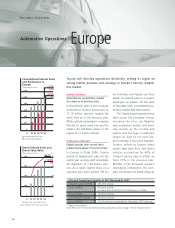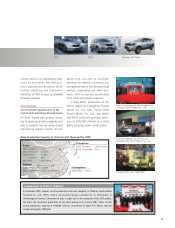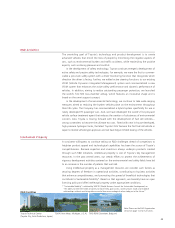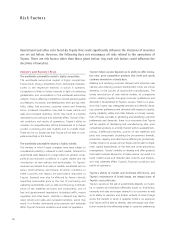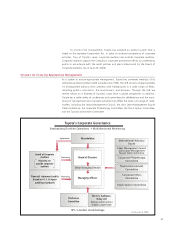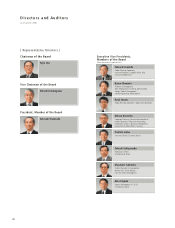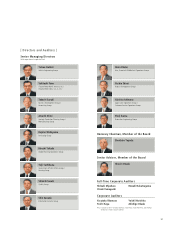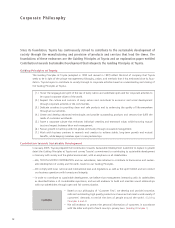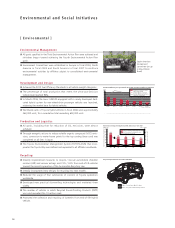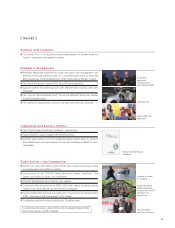Toyota 2006 Annual Report Download - page 47
Download and view the complete annual report
Please find page 47 of the 2006 Toyota annual report below. You can navigate through the pages in the report by either clicking on the pages listed below, or by using the keyword search tool below to find specific information within the annual report.
45
or changes in the regulatory environment in the major markets
in which it operates. Nor is there assurance that Toyota will be
able to cultivate and protect its brand image. Toyota’s inability
to maintain well developed sales techniques and distribution
networks or brand image may result in decreased sales and
market share and may adversely affect its financial conditions
and results of operations.
The worldwide financial services industry is highly competitive.
The worldwide financial services industry is highly competitive.
The market for automobile financing has grown as more con-
sumers are financing their purchases, primarily in North America
and Europe. Increased competition in automobile financing
may lead to decreased margins. A decline in Toyota’s vehicle
unit sales, an increase in residual value risk due to lower used
vehicle price and increased funding costs are factors which may
impact Toyota’s financial services operations. A negative impact
on Toyota’s financial services operations may adversely affect its
financial conditions and results of operations.
Political, Regulatory and Economic Risks
Toyota’s operations are subject to currency and interest rate
fluctuations.
Toyota is sensitive to fluctuations in foreign currency exchange
rates and is principally exposed to fluctuations in the value of
the Japanese yen, the U.S. dollar and the euro and, to a lesser
extent, the Australian dollar and the British pound. Toyota’s
consolidated financial statements, which are presented in
Japanese yen, are affected by foreign currency exchange fluctu-
ations through both translation risk and transaction risk.
Changes in foreign currency exchange rates may affect Toyota’s
pricing of products sold and materials purchased in foreign cur-
rencies. In particular, a strengthening of the Japanese yen
against the U.S. dollar can have a material adverse effect on
Toyota’s operating results.
Toyota believes that its use of certain derivative financial
instruments and increased localized production of its products
have reduced, but not eliminated, the effects of interest rate
and foreign currency exchange rate fluctuations, which in some
years can be significant. Nonetheless, a negative impact result-
ing from fluctuations in foreign currency exchange rates and
changes in interest rates may adversely affect Toyota’s financial
conditions and results of operations. For a further discussion of
currency and interest rate fluctuations and the use of derivative
financial instruments, please see “Management’s Discussion
and Analysis of Financial Condition and Results of Operations—
Overview—Currency Fluctuations (page 64)” and “Quantitative
and Qualitative Disclosures about Market Risk (page 84),” and
notes 20 and 21 (page 117) to Toyota’s consolidated financial
statements.
The automotive industry is subject to various governmental
regulations and legal proceedings.
The worldwide automotive industry is subject to various gov-
ernmental laws and regulations including those related to
vehicle safety and environmental matters such as emission levels,
fuel economy, noise and pollution. Many governments also reg-
ulate local content, impose tariffs and other trade barriers, taxes
and levies, and enact price or exchange controls. Toyota has
incurred, and expects to incur in the future, significant costs in
complying with these regulations. New legislation or changes in
existing legislation may also subject Toyota to additional expense
in the future. Toyota is also subject to a number of pending legal
proceedings. A negative outcome in one or more of these pend-
ing legal proceedings could adversely affect Toyota’s future
financial conditions and results of operations.
Toyota may be adversely affected by political instabilities,
fuel shortages or interruptions in transportation systems,
natural calamities, wars, terrorism and labor strikes.
Toyota is subject to various risks associated with conducting
business worldwide. These risks include political and economic
instability, natural calamities, fuel shortages, interruption in
transportation systems, wars, terrorisms, labor strikes and work
stoppages. The occurrence of any of these events in the major
markets in which Toyota purchases materials, components and
supplies for the manufacture of its products, or in which its
products are produced, distributed or sold, may result in disrup-
tions and delays in the operations of Toyota’s business.
Significant or prolonged disruptions and delays in Toyota’s busi-
ness operations may result to adversely affect Toyota’s financial
conditions and results of operations.



